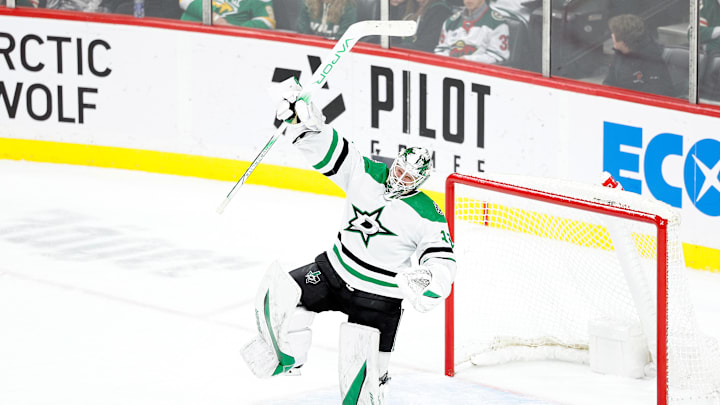The Dallas Stars had a great holiday season, going 8-3-2 (18 of 26 points) from Dec. 15 through Jan. 10 (13 games). They have continued to succeed despite the absences of Miro Heiskanen (injured Jan 4. vs. Colorado) and Jake Oettinger (injured Dec. 15 vs. Ottawa).
There are multiple storylines to follow as Dallas traverses through the National Hockey League (NHL) regular season without their #1 defenseman and starting goaltender. This article will outline the Dallas Stars' statistical results from all games from Monday, December 15th vs. Ottawa through Wednesday, January 10th vs. Minnesota (13 GP).
Overall Stats
The Dallas Stars sit 3rd in the Central Division with a 24-11-5 record (53 points), trailing Winnipeg (58 points) and Colorado (57 points). Dallas also ranks 4th in the Western Conference and 7th in the entire NHL. This is great, but I worry about getting stuck in the 2nd or 3rd seed in the Central division, where the first-round playoff opponent for Dallas would be Colorado or Winnipeg.
The Stars must finish 1st in the Central Division to avoid Colorado or Winnipeg early in the playoffs.
Over the last month, Dallas has achieved the following results (13 GP):
- 8-3-2, 18 points (T-3rd NHL)
- .692 Points Percentage (8th NHL)
- 54 Goals For (1st NHL)
- 38 Goals Against (T-17th NHL)
- 18.2% PowerPlay (21st NHL)
- 81.6% Penalty Kill (12th NHL)
The Stars are outplaying teams like their offense should do while showing fair defensive numbers considering the Heiskanen and Oettinger injuries. Let's look at the underlying numbers that may provide further context to these stats.
Dallas Stars Statistical Breakdown: NaturalStatTrick
In the three games since Heiskanen’s injury, Dallas’ defensive structure has been resilient and surprisingly dependable. Specifically, here are the most common pairings and their on-ice numbers at 5v5:
Pair | 5v5 Mins. | FF% | xGF% | HDCF% |
|---|---|---|---|---|
Lindell-Hakanpaa | 42 | 46% | 47% | 50% |
Suter-Lundkvist | 34 | 58% | 61% | 67% |
Hanley-Harley | 34 | 57% | 80% | 83% |
As you can see from the numbers, the Lindell-Hakanpaa pairing is having trouble at 5v5, but this has been known to be an area of weakness for the two Finns. The penalty kill has been great all year, blocking shots and diverting pass attempts while allowing the penalty-killing forwards to outscore opposing power plays. I’d look to deploy the other two pairs more at 5v5, especially since the offense is doing well, making the Stars’ “defensive-oriented” pairing less vital in such premier minutes.
For those who are curious about Miro Heiskanen’s value for the Stars, here are two key statistics that explain Miro Heiskanen’s current season:
Among NHL defensemen to play over 200 minutes at 5v5 this season, Heiskanen is ranked 20th in FF% (unblocked shot attempts) at 55%, T-4th in xGF% (shot value) at 59%, and 8th in HDCF% (high-value attempts). Miro Heiskanen is a top defender and an elite offensive facilitator in the NHL.
Heiskanen has been quite unlucky this season, with a 0.985 5v5 PDO (on-ice shooting % + save %), ranked 168th among all NHL defensemen with over 200 5v5 minutes this season. For reference, Vancouver’s Filip Hronek is 1st with a 1.079 5v5 PDO. This means that there is a 10% difference in goalies' saving + shooters' scoring when Filip Hronek is on the ice compared to Miro Heiskanen (simply put). Heiskanen has had a combination of bad-finishing shooters, poor goaltending, bad luck, or something else because 167 players who play 200+ 5v5 minutes are faring better than he has, and Heiskanen is a good hockey player.
Dallas Stars Statistical Breakdown: Moneypuck.com
Further to Heiskanen’s impact, among D pairings that have played over 100 minutes together, Harley-Heiskanen leads the entire NHL with a 72.1% xGoals %. If Dallas ever needs a goal, this pair is better than any D pairing out there.
One final key aspect of the Stars’ recent run is their goaltending. Scott Wedgewood is 12-4-3 on the season and has battled in each game he’s played since Oettinger went down. Matt Murray even got his first NHL shutout against the Minnesota Wild. Things seem okay for the Stars’ goaltenders, but can this stability last? And is Scott Wedgewood doing well?
HOW ABOUT THAT FOR MATT MURRAY'S FIRST CAREER @NHL SHUTOUT?! pic.twitter.com/T8ZTUEDdaE
— Dallas Stars (@DallasStars) January 9, 2024
Matt Murray saved 2.04 goals above expected in his shutout against the Wild, which already puts him 36th in the league in Goals Saved Above Expected if you set the minimum to one game. For a fair sample, among goalies to have played 10+ games, Scott Wedgewood ranks 61st among 64 eligible goalies with a -9.4 Goals Saved Above Expected. Simply put, Scott Wedgewood has conceded 9.4 goals more than the total value of all opponent shots (59 Goals Against, 49.61 Expected Goals Against). This is not great, but with Dallas going 7-3-2 with him in the net over the last month, does it matter?
As long as Jake Oettinger is healthy for the playoffs, Wedgewood’s analytics don’t matter.
Jake Oettinger will play every playoff game if healthy, so the fancy stats that are sold to the public as the truth are still factual, but they won’t change anything at this point in the season and don’t necessarily matter, as long as the Stars can keep winning games.
Conclusion
Despite injuries to key players, the Dallas Stars are in a good spot. They are scoring at an elite rate, shutting out division rivals, and playing smooth and fluid hockey for the most part. I am excited to see if Jake Oettinger returns because that could take the Stars to another level. As the March 8th trade deadline approaches, I hope the offensive abilities of the Dallas Stars do not mask the need to add reinforcements on defense because the teams we’re currently beating are not the teams we will likely see in the playoffs.
